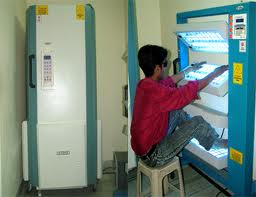PUVA Therapy
 PUVA is an ultraviolet light therapy treatment of psoriasis,graft-versus-host disease, vitiligo, mycosis fungoides, large-plaque parapsoriasis and cutaneous T-cell lymphoma using the sensitizing effects of the drug psoralen. The psoralen is applied or taken orally to sensitize the skin, then the skin is exposed to UVA
PUVA is an ultraviolet light therapy treatment of psoriasis,graft-versus-host disease, vitiligo, mycosis fungoides, large-plaque parapsoriasis and cutaneous T-cell lymphoma using the sensitizing effects of the drug psoralen. The psoralen is applied or taken orally to sensitize the skin, then the skin is exposed to UVA
 Psoralens are photosensitizing agents found in plants. Psoralens are taken systemically or can be applied directly to the skin. The psoralens allow a relatively lower dose of UVA to be used. When they are combined with exposure to UVA in PUVA, they are highly effective at clearing psoriasis and vitiligo. Like UVB light treatments, the reason remains unclear, though investigators speculate there may be similar effects on cell turnover and the skin’s immune response. At the very least for vitiligo, narrowband ultraviolet B (UVB) phototherapy is now used more commonly than PUVA since it does not require the use of the Psoralen. As with PUVA, treatment is carried out twice weekly in a clinic or every day at home, and there is no need to use psoralen.
Psoralens are photosensitizing agents found in plants. Psoralens are taken systemically or can be applied directly to the skin. The psoralens allow a relatively lower dose of UVA to be used. When they are combined with exposure to UVA in PUVA, they are highly effective at clearing psoriasis and vitiligo. Like UVB light treatments, the reason remains unclear, though investigators speculate there may be similar effects on cell turnover and the skin’s immune response. At the very least for vitiligo, narrowband ultraviolet B (UVB) phototherapy is now used more commonly than PUVA since it does not require the use of the Psoralen. As with PUVA, treatment is carried out twice weekly in a clinic or every day at home, and there is no need to use psoralen.
Narrowband UVB does not cure the legs and hands, compared to the face and neck. To the hands and legs PUVA may be more effective. The reason can be because UVA penetrates deeper in the skin, and the melanocytes in the skin of the hands and legs is deeper in the skin. The Narrowband UVB does not reach the melanocytes.